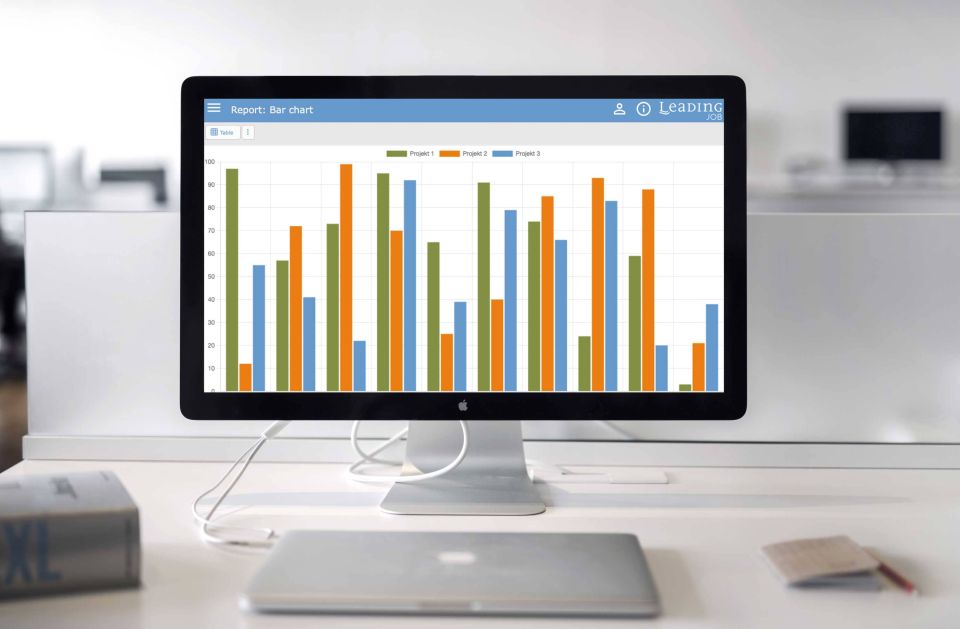How to Make Your Agency Controlling a Success | + Software Solutions
Organise your agency's controlling more efficiently and digitally. With LEADING Job, we have developed an all-in-one agency software that is specially tailored to the needs of leading companies in the creative industry. In addition to the controlling functions, LEADING Job includes numerous other tools for organising day-to-day agency work.

Table of Content
Why controlling is important for agencies
Agency controlling: What it's all about
Relevant KPI for agency controlling
Timesheets as the key to cost control
Success factor profitability calculation
How to deal with non-chargeable costs
Analysis with business intelligence tools
Software for agency controlling LEADING Job from Qualiant
Request software for agency controlling: Get in touch now!
Why Controlling Is Important for Agencies
Controlling is probably the least favourite discipline in agencies that work primarily creatively. However, as commercial organisations, creative agencies also need to keep an eye on their key figures. After all, you can only pursue your passion in the long term if creativity and profitability go hand in hand. Without controlling, problems only become apparent when it is almost too late. If you set up your controlling properly in your agency, you can keep an overview of your economic situation and recognise problems at an early stage, but also understand which measures are going well. In turn, controlling ensures that your head and back are free to realise creative projects.
Agency Controlling: Here's What It's All About
Reporting is often used synonymously with the term controlling. However, while reporting is designed to provide evidence to clients or the agency network, controlling is intended for internal use.
This involves recording who has spent how many hours on which tasks on certain projects - and what costs and revenue this results in for the agency. To this end, controlling key figures such as costs, turnover, times, external costs and similar are recorded. Only through controlling does the agency realise which projects and customers are particularly financially worthwhile and which projects do not have a healthy relationship between costs and income.
On this basis, a strategy can be developed as to which projects contribute to the company's economic goals and where processes can be optimised. This supports the decision as to which projects the agency will invest its resources in in the future. It also makes it clear in which projects the team's creative energy is best utilised. A healthy growth of agencies is generally only possible if the potential for scaling is determined beforehand with the help of controlling. The need to increase hourly rates, if necessary, also becomes visible through controlling - and can be justified to clients. Controlling also helps to explain strategic management decisions to the team. This is because decisions are not simply made "on instinct", but on the basis of comprehensible and transparent figures.
Relevant KPIs for Agency Controlling
Depending on the specific goals you are pursuing with agency controlling, it is advisable to record a different number of key figures. Of course, it is also possible to initially record only the most important key figures and then gradually refine the controlling. In the context of creative agencies, the following key figures are particularly relevant:

- Contribution margin per project: This is used to calculate whether a project is profitable. Internal costs and external costs are deducted from the turnover. The contribution margin should of course be as high as possible, but must never be negative. Otherwise you will have made a loss on the project. In order to calculate the internal costs, time should be recorded for the respective tasks within the scope of the project.
- Budget allocation per project: In order to achieve the project goals agreed with the customer, you should keep an eye on how much budget time is still available to complete the project. This allows you to recognise at an early stage whether the effort invested is in good proportion to the total volume of the project.
- Sales forecast: With a sales forecast, you can visualise the upcoming workload and the expected revenue of your agency. For this purpose, the expected invoices and confirmed offers are recorded as part of the controlling process. A sales forecast is extremely important to ensure that the agency remains financially healthy in the long term.
These three key figures are the most important basis for agency controlling. The quality of the data can, of course, be improved if additional data is included. In particular, time recording and cost tracking are helpful key figures for determining the economic success of projects.
However, the scope of the key figures collected should not be extended indefinitely. In small and medium-sized companies in particular, this would otherwise result in expenditure without any real added value and controlling would soon be done just for the sake of controlling. It is important that the key figures collected are actually used for strategic decisions. In addition, creative agencies in particular should always remember that figures are not everything. Creative agencies also have work to do, which may not always lead directly to greater economic success. By pursuing quantitative goals, however, qualitative goals and demands should never be lost sight of.
Success Factors for Agency Controlling
Centralisation of Data
Controlling only offers added value if it is well thought out. It is important that the data is recorded as digitally as possible and in one system. To do this, it is advisable to use specialised software such as LEADING JOB, which is tailored to the needs of creative agencies. This prevents the need for numerous isolated solutions, which then have to be merged again at additional expense. In a customised agency software, on the other hand, the required data is collected, aggregated and processed in one place.
Timesheets as the Key to Cost Control
When it comes to time recording, digital solutions are particularly suitable so that team members are not distracted from their core business by additional record keeping tasks. This is why LEADING Job, for example, has an integrated, digital tool for time recording. The data collected is processed directly for controlling. An example: You are delighted to have a well-known dream client for whom you can realise large campaigns as an exclusive agency. But the dream soon turns into a nightmare when it comes to the admin workload for the account manager or in the accounts department caused by the not at all ideal nature of the collaboration with the new major client. Using the data from the time recording system, you can determine the relationship between the customer's net income and the proportion of personnel costs they generate. And by adjusting the pricing for future projects accordingly, you can bring the expenses for this customer back down to a reasonable level.
Key Success Factor Profitability Calculation
With LEADING Job, you can compare current profits and contribution margins with the planned target values at the start of the project in real time. While your projects are running, you can see whether the planned profit targets and deadlines are being achieved or whether there is a t or deadline delay. The traffic light visualisation - red for urgent need for action, yellow for early warnings and green for performance in the desired range - facilitates a quick overview.
Dealing with Non-chargeable Costs
Non-chargeable costs are expenses that are generated as part of a project but cannot be charged directly to the customer. These include, for example, courier services or other small costs. With the LEADING Job controlling tool, these costs can still be easily allocated to the respective customers. This enables a realistic distribution of costs instead of posting them as overheads across the board. This helps to better monitor the profitability of projects and to calculate future offers more precisely by taking into account the non-chargeable costs incurred by customers.
Analysis with Business Intelligence Tools
It is also helpful if specialised analytics tools can continue to work with the data collected in the agency software for controlling. For example, the data in LEADING Job can be automatically exported at regular intervals and further processed with leading business intelligence tools such as Microsoft Power BI, Oracle BI, Jedox or Business Objects.

Software for Agency Controlling LEADING Job by Qualiant
We developed LEADING Job with the aim of meeting the needs of the creative industry and project-orientated service providers in a sophisticated agency software. Our all-in-one agency software bundles all the important tasks of day-to-day agency work in one place - from utilisation planning and time recording to controlling. LEADING Job helps leading companies in the creative industry to utilise their resources efficiently. In this way, even larger projects can be successfully managed and the necessary space for creative ideas is created.
These strengths and functions of LEADING Job enable success-orientated controlling for creative agencies:
- Broad range of functions for proposal preparation, project management, time recording, controlling, invoicing, reporting, workflow and resource planning
- Full customisation for agile, international project work that saves time and money
- Always stably available as a web-based cloud solution on both desktop and mobile devices
- Support by phone, chat & email, included update service, training courses & workshops by arrangement
- Risk-free trial for up to three months
Request Software for Agency Controlling: Get in Touch Now!
Find out more about how LEADING Job can support your business success and help you set up efficient agency controlling. Simply contact us and let us advise you individually on how you can make processes in your agency more digital, more efficient and more successful.
